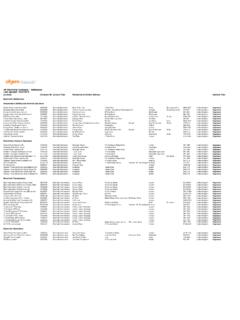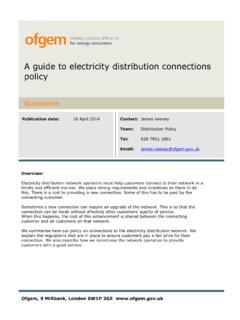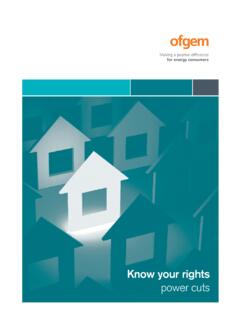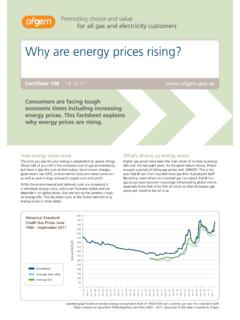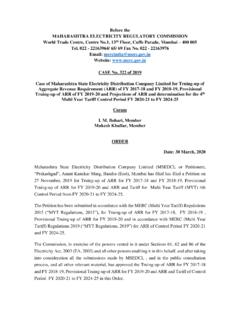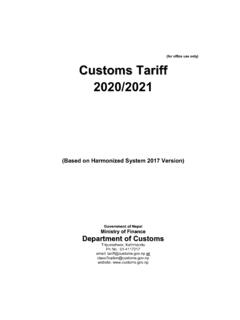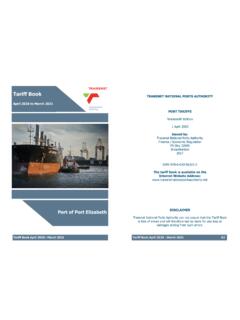Transcription of Default tariff cap update from 1 October 2021
1 The Office of Gas and Electricity Markets 10 South Colonnade, Canary Wharf, London, E14 4PU Tel 020 7901 7000 Dear colleagues, Default tariff cap update from 1 October 2021 Today we have published the updated cap levels for the seventh charge restriction period ( the seventh cap period ), covering the six months from 1 October 2021 to 31 March 2022. Alongside the cap levels we have also published the updated versions of the cost allowance models / annexes. Drivers of change The level of the cap12 for the seventh period (1 October 2021 to 31 March 2022) has increased by 12% since the last update . From 1 October 2021, the level of the cap will increase to 1, ,4 The main drivers for this change are due to updates in the model inputs for: Wholesale costs These have increased by 155 since the last update . A combination of lower supply of gas imports due to global recovery, especially increased demand from Asia and protracted cold spells over last winter and into spring, have led to lower-than-normal amounts of gas left in storage across Europe.
2 Continued low imports and the need to re-fill these gas storage sites for next winter has driven gas demand and forward gas prices over recent months. Wholesale electricity prices have also been pushed up by higher gas prices and an increase in prices for carbon allowances. Policy costs Policy costs have decreased by 13 since the last update . This is almost exclusively driven by a fall in CfD costs, due to the fact that the Low Carbon Contracts Company (LCCC) have had a surplus of income over payments collected 1 The level of the cap shown is for a dual fuel, direct debit customer, calculated using the latest Typical Domestic Consumption Values (TDCVs). All values rounded to the nearest . 2On 1 April 2020 Ofgem decided to decrease the Typical Domestic Consumption Values (TDCVs) for electricity to reflect continued decreases in consumption for electricity and to keep the TDCV s for gas unchanged.
3 From 1 April 2020, Ofgem has been using the new TDCVs to express the Default tariff price cap and prepayment meter cap level in all publications. Previous publications on the levels of the caps will therefore not be the same / directly comparable. 3 The Default tariff cap sets maximum prices, not maximum bills. For an individual customer, the amount they will pay under the cap varies depending on how much energy they use, where they live, and how they pay for their energy. The cap level will not depend on who a customer s energy supplier is. 4 We do not set a dual fuel cap. Caps are set for each fuel separately. When we express the dual fuel cap level for a typical customer, this is the combined effect of the gas cap at typical consumption and the electricity cap at typical consumption. To all market participants and interested parties Email: Date: 06 August 2021 The Office of Gas and Electricity Markets 10 South Colonnade, Canary Wharf, London, E14 4PU Tel 020 7901 7000 since the start of Q1 2021, caused by lower than expected generator payments and higher power prices.
4 Smart meter rollout (SMNCC) allowance - Our decision on the allowance for the smart meter rollout means the allowance has decreased by 3 since the last update . We have decided to set a lower allowance following our updated analysis for the additional costs of smart metering since 2017 (above those included in the operating cost allowance). In particular, this takes into account BEIS s confirmation of its new smart meter policy framework (which will be implemented from 1 January 2022), and that we have more information about the impact of COVID-19 on suppliers smart meter installation costs. Covid-19 cost impact adjustment - In our February decision, we concluded that suppliers had experienced material additional costs when supplying credit customers. We therefore included an adjustment allowance for the additional costs relating to bad debt in the credit levels of the cap. We set out that in order to minimise the impact on consumers of higher bills, suppliers would have to recover some of the costs in a phased approach between April 2021 and March 2022.
5 We spread the costs of cap periods four and five over two periods. There is no new allowance related to Covid-19 for either credit or PPM customers in cap period seven. Therefore, only the remaining float of 95 is included in cap period seven for credit customers in line with our February 2021 decision. Changes in the components making up the direct debit level of the cap (shown for dual fuel) are shown in Figure 1 below:6 Period 6 (Apr 21 Sept 21) Period 7 (Oct 21 Mar 22) Wholesale 373 528 Policy 172 159 Adjustment allowance7 23 9 Network 268 268 Operating costs 204 204 Payment uplift 12 12 EBIT 20 23 Headroom 12 14 VAT 54 61 Total 1,138 1,277 Figure 1: Breakdown of Default tariff cap components 5 Adjustment expressed in new TDCV ( ). With benchmark consumption the adjustment is 6 All values shown are for a dual fuel, direct debit customer, calculated using the latest Typical Domestic Consumption Values (TDCVS).
6 All values rounded to the nearest . 7 An allowance covering any adjustments to the Default tariff cap. For cap period six this includes the Covid-19 adjustment to cover the incremental cost due to COVID-19 for suppliers writing off bad debt for credit customers for cap periods four to six. For cap period seven there is not an additional adjustment related to Covid-19 to either credit or PPM customers. Therefore, the remaining float of (with benchmark consumption) will be applied in cap period seven for credit customers in line with our February 2021 decision. 0 200 400 600 800 1,000 1,200 1,400 Period 7 VATH eadroomEBITP aymentupliftOperatingcostsNetworkAdjustm entallowancePolicyWholesale The Office of Gas and Electricity Markets 10 South Colonnade, Canary Wharf, London, E14 4PU Tel 020 7901 7000 Other payment methods The standard credit cap level has also increased and will be 1,370 ( 147 increase). This reflects the changes to wholesale prices, policy costs and the SMNCC described above.
7 The 1,370 per year level of the cap is based on a household with typical consumption on a dual electricity and gas bill paying by direct debit. Customers who pay by standard credit (cash or cheque) pay an additional 93 based on the higher cost for suppliers to serve them. The prepayment meter (PPM) cap level has also increased and will be 1,309 ( 153 increase). As for customers who pay by standard credit, customers on prepayment meters pay an additional 32 based on the higher cost for suppliers to serve them in comparison to customers paying by direct debit. The increase in the PPM cap level is greater than the credit cap levels (direct debit and standard credit) because the increase in wholesale costs is not netted off by a reduction in COVID-19 related additional allowance, as it is in credit cap levels. This is because, while we provided suppliers an additional allowance for COVID-19 for the credit cap levels of the cap in the April 2021 cap level, we did not include a similar allowance for the PPM cap level.
8 This means that there is no reduction in this allowance to reflect in the October PPM cap However, as a result of our latest review of smart metering costs, the SMNCC allowance in the PPM cap level has reduced more than the SMNCC for credit (by 5 since the last update ), reflecting the different costs and benefits. Compliance with the price caps We expect suppliers to take seriously their obligations to implement the Default tariff cap and will be closely monitoring their compliance. Suppliers should continue to comply with their obligations as set out in and , and the values used in those licence conditions. We will continue to take firm action against suppliers who fall short of their price cap requirements. We expect any related data provided to Ofgem to be accurate, complete and provided in a timely manner. We will also continue to monitor the quality of service suppliers deliver to their customers and stand ready to take compliance and enforcement action in the event that any licence requirements are not met.
9 Yours faithfully, Anna Rossington Deputy Director, Retail Transformation 8 We have decided not to include an allowance in cap period seven for additional costs as a result of COVID-19 for serving PPM customers. This is because we consider that the evidence at this stage indicates that the effects of COVID-19 on supplying PPM customers are limited. The Office of Gas and Electricity Markets 10 South Colonnade, Canary Wharf, London, E14 4PU Tel 020 7901 7000 Annex Annex 1 Changes to the Default tariff cap split by payment method. Cap level Period 6 (Apr 21 Sept 21) Period 7 (Oct 21 Mar 22) Direct Debit 1,138 1,277 Standard Credit 1,223 1,370 Prepayment 1,156 1,309



